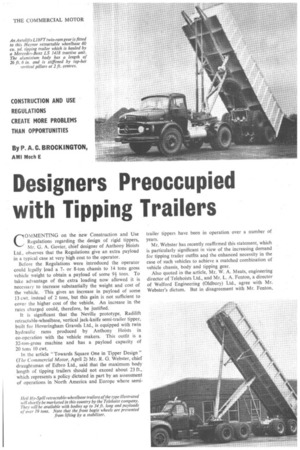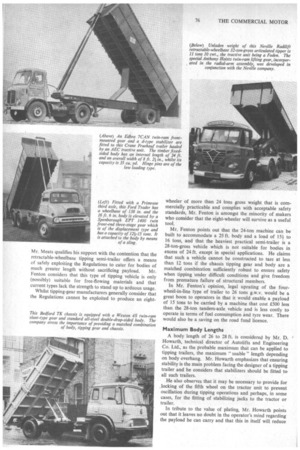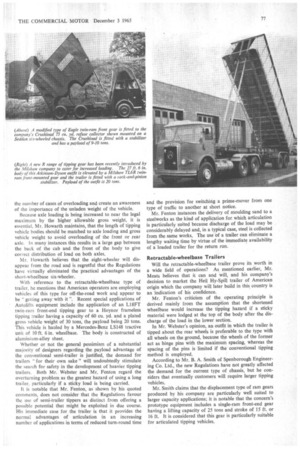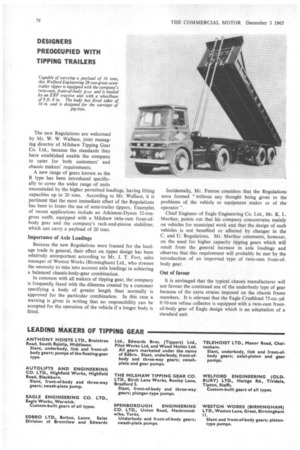Designers Preoccupied with Tipping Trailers
Page 77

Page 78

Page 79

Page 80

If you've noticed an error in this article please click here to report it so we can fix it.
COMMENTING on the new Construction and Use Regulations regarding the design of rigid tippers, Mr. G. A. Govier, chief designer of Anthony Hoists Ltd., observes that the Regulations give an extra payload in a typical case at very high cost to the operator. Before the Regulations were introduced the operator could legally load a 7or 8-ton chassis to 14 tons gross vehicle weight to obtain a payload of some 9tons. To take advantage of the extra loading now allowed it is necessary to increase substantially the weight and cost of the vehicle. This gives an increase in payload of some 13 cwt. instead of 2 tons, but this gain is not sufficient to cover the higher cost of the vehicle. An increase in the rates charged could, therefore, be justified. It is significant that the Neville prototype, Radilift retractable-wheelbase, vertical jack-knife semi-trailer tipper, built for Hoveringham Gravels Ltd., is equipped with twin hydraulic rams produced by Anthony Hoists in co-operation with the vehicle makers. This outfit is a 32-ton-gross machine and has a payload capacity of 20 tons 10 cwt. In the article "Towards Square One in Tipper Design" (The C'ommercial Motor, April 2) Mr. R. G. Webster, chief draughtsman of Edbro Ltd., said that the maximum body length of tipping trailers should not exceed about 23 ft., which represents a policy dictated in part by an assessment of operations in North America and Europe where semi trailer tippers have been in operation over a number of years. Mr. Webster has recently reaffirmed this statement, which is particularly significant in view of the increasing demand for tipping trailer outfits and the enhanced necessity in the case of such vehicles to achieve a matched combination of vehicle chassis, body and tipping gear. Also quoted in the article, Mr. W. A. Meats, engineering director of TeIehoists Ltd., and Mr. L. A. Fenton, a director of Welford Engineering (Oldbury) Ltd., agree with Mr. Webster's dictum. But in disagreement with Mr. Fenton, Mr. Meats qualifies his support with the contention that the retractable-wheelbase tipping semi-trailer offers a means of safely exploiting the Regulations to cater for bodies of much greater length without sacrificing payload. Mr. Fenton considers that this type of tipping vehicle is only (nossibly) suitable for free-flowing materials and that current types lack the strength to stand up to arduous usage. Whilst tipping-gear manufacturers generally consider that the Regulations cannot be exploited to produce an eight wheeler of more than 24 tons gross weight that is commercially practicable and complies with acceptable safety standards, Mr. Fenton is amongst the minority of makers who consider that the eight-wheeler will survive as a useful tool. • Mr. Fenton points out that the 24-ton machine can be built to accommodate a 23 ft. body and a load of 15+ to 16 tons, and that the heaviest practical semi-trailer is a 28-ton-gross vehicle which is not suitable for bodies in excess of 24 ft. except in special applications. He claims that such a vehicle cannot be constructed to tare at less than 12 tons if the chassis tipping gear and body are a matched combination sufficiently robust to ensure safety when tipping under difficult conditions and give freedom from premature failure of structural members.
In Mr. Fenton's opinion, legal uprating of the fourwheel-in-line type of trailer to 26 tons g.w.v. would be a great boon to operators in that it would enable a payload of 15 tons to be carried by a machine that cost 000 less than the 28-ton tandem-axle vehicle and is less costly to operate in terms of fuel consumption and tyre wear. There would also be a saving on the road fund licence.
Maximum Body Lengths A body length of 26 to 28 ft. is considered by Mr. D. Howarth, technical director of Autolifts and Engineering Co. Ltd., as the probable maximum that can be applied to tipping trailers, the maximum "usable" length depending on body overhang. Mr. Howarth emphasizes that ensuring stability is the main problem facing the designer of a tipping trailer and he considers that stabilizers should be fitted to all such trailers.
He also observes that it may be necessary to provide for .locking of the fifth wheel on the tractor unit to prevent oscillation during tipping operations and perhaps, in some cases, for the fitting of stabilizing jacks to the tractor or trailer.
In tribute to the value of plating, Mr. Howarth points out that it leaves no doubt in the operator's mind regarding the payload he can carry and that this in itself will reduce the number of cases of overloading and create an awareness of the importance of the unladen weight of the vehicle.
Because axle loading is being increased to near the legal maximum by the higher allowable gross weight, it is essential, Mr. Howarth maintains, that the length of tipping vehicle bodies should be matched to axle loading and gross vehicle weight to avoid overloading of the front or rear axle. In many instances this results in a large gap between the back of the cab and the front of the body to give correct distribution of load on both axles.
Mr. Howarth believes that the eight-wheeler will disappear from the road and is regretful that the Regulations have virtually eliminated the practical advantages of the short-wheelbase six-wheeler.
With reference to the retractable-wheelbase type of trailer, he mentions that American operators are employing vehicles of this type for off-the-road work and appear to be "getting away with it ". Recent special applications of Autolifts equipment include the application of an L18FT twin-rain front-end tipping gear to a Hoynor frameless tipping trailer haying a capacity of 60 cu. yd. and a plated gross vehicle weight of 30 tons, the payload being 20 tons. This vehicle is hauled by a Mercedes-Benz LS148 tractive unit of 10 ft. 6 in. wheelbase. The body is constructed of aluminium-alloy sheet.
Whether or not the general pessimism of a substantial majority of designers regarding the payload advantage of the conventional semi-trailer is justified, the demand for trailers "for their own sake" will undoubtedly stimulate the search for safety in the development of heavier tipping trailers. Both Mr. Webster and Mr. Fenton regard the overturning problem as the greatest hazard of using a long trailer, particularly if a sticky load is being carried.
It is notable that Mr. Fenton, as shown by his quoted comments, does not consider that the Regulations favour the use of semi-trailer tippers as distinct from offering a possible potential that might be exploited in due course. His immediate case for the trailer is that it provides the normal advantages of articulation in an increasing number of applications in terms of reduced turn-round time and the provision for switching a prime-mover from one type of traffic to another at short notice. Mr. Fenton instances the delivery of moulding sand to a steelworks as the kind of application for, which articulation is particularly suited because discharge of the load may be considerably delayed and, in a typical case, steel is collected from the same works. The use of a trailer can eliminate a lengthy waiting time by virtue of the immediate availability of a' loaded trailer for the return run.
Retractable-wheelbase Trailers Will the retractable-wheelbase trailer prove its worth in a wide field of operations? As, mentioned earlier, Mr. Meats believes that it can and will, and his company's decision to market the Heil Hy-Spill trailer of American origin which the company will later build in this country is an indication of his confidence.
Mr. Fenton's criticism of the operating principle is derived mainly from the assumption that the shortened wheelbase would increase the tipping hazard if a sticky material were lodged at the top of the body after the discharge of the load in the lower section. In Mr. Webster's opinion, an outfit in which the trailetis tipped about the rear wheels is preferable to the type with all wheels on the ground, because the wheels of the former act as hinge pins with the maximum spacing, whereas the spacing of the pins is limited if the conventional tipping method is employed.
According to Mr. B. A. Smith of Spenborough Engineering Co. Ltd., the new Regulations have not greatly affected the demand for the current type of chassis, but he considers that eventually customers will require larger tipping vehicles.
Mr. Smith claims that the displacement type of ram gears produced by his company are particularly well suited to larger capacity applications; it is notable that the concern's prototype equipment includes a single-ram front-end gear having a lifting capacity of 25 tons and stroke of 15 ft. or 16 ft. It is considered that this gear is particularly suitable for articulated tipping vehicles. The new Regulations are welcomed by Mr. W. W. Wallace, joint managing director of Milshaw Tipping Gear Co. Ltd., because the standards they have established enable the company to cater for both customers' and chassis makers' requirements.
A new range of gears known as the R type has been introduced specifically to cover the wider range of units necessitated by the higher permitted loadings, having lifting capacities up to 20 tons. According to Mr. Wallace, it is pertinent that the most immediate effect of the Regulations has been to foster the use of semi-trailer tippers. Examples of recent applications include an Atkinson-Dyson 32-tongross outfit, equipped with a Milshaw twin-ram front-ofbody gear and the company's rack-and-pinion stabilizer, which can carry a payload of 20 tons.
Importance of Axle Loadings Because the new Regulations were framed for the haulage trade in general, their effect on tipper design has been relatively unimportant according to Mr. J. T. Fort, sales manager of Weston Works (Birmingham) Ltd., who stresses the necessity to take into account axle loadings in achieving a balanced chassis-body-gear combination.
In common with all makers of tipping gear, the company is frequently faced with the dilemma created by a customer specifying a body of greater length than normally is approved for the particular combination. In this case a warning is given in writing that no responsibility can be accepted for the operation of the vehicle if a longer body is fitted. Incidentally, Mr. Fenton considers that the Regulations were formed "without any thought being given to the problems of the vehicle or equipment maker or of the operator ".
Chief Engineer of Eagle Engineering Co. Ltd., Mr. K. L. Merther, points out that his company concentrates mainly on vehicles for municipal work and that the design of such vehicles is not benefited or affected by changes in the C. and U. Regulations. Mr. Merther comments, however, on the need for higher capacity tipping gears which will result from the general increase in axle loadings and observes that this requirement will probably be met by the introduction of an improved type of twin-ram front-ofbody gear.
Out of favour It is envisaged that the typical chassis manufacturer will not favour the continued use of the underbody type of gear because of the extra strains imposed on the chassis frame members. It is relevant that the Eagle Crushload 75-cu.-yd. 9/10-ton refuse collector is equipped with a twin-ram frontof-body gear of Eagle design which is an adaptation of a standard unit.
















































































































































































